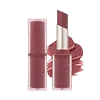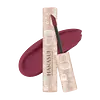What's inside
What's inside
 Key Ingredients
Key Ingredients

 Benefits
Benefits

 Concerns
Concerns

 Ingredients Side-by-side
Ingredients Side-by-side

Dimethicone
EmollientDibutyl Adipate
EmollientHydrogenated Polyisobutene
EmollientSynthetic Beeswax
Emulsion StabilisingVinyl Dimethicone/Methicone Silsesquioxane Crosspolymer
Diisopropyl Dimer Dilinoleate
EmollientPolymethylsilsesquioxane
Polyglyceryl-2 Triisostearate
EmulsifyingCI 77891
Cosmetic ColorantDimethicone Crosspolymer
Emulsion StabilisingCI 77491
Cosmetic ColorantSilica
AbrasiveCaprylic/Capric Triglyceride
MaskingCopernicia Cerifera Wax
Rubus Occidentalis Seed Oil
EmollientSimmondsia Chinensis Seed Oil
EmollientCaprylic/Capric/Myristic/Stearic Triglyceride
EmollientDicalcium Phosphate
AbrasiveSorbitan Isostearate
EmulsifyingDiphenylsiloxy Phenyl Trimethicone
Skin ConditioningEuphorbia Cerifera Wax
Phytosteryl/Octyldodecyl Lauroyl Glutamate
Skin ConditioningPolyglyceryl-2 Diisostearate
EmulsifyingDimethicone/Vinyl Dimethicone Crosspolymer
Skin ConditioningStearalkonium Hectorite
Gel FormingSilica Dimethyl Silylate
EmollientSucrose Tetrastearate Triacetate
EmollientPropylene Carbonate
SolventTocopherol
AntioxidantParfum
MaskingCI 15850
Cosmetic ColorantCI 42090
Cosmetic ColorantCI 77499
Cosmetic ColorantMica
Cosmetic ColorantCI 15985
Cosmetic ColorantCI 17200
Cosmetic ColorantCI 77492
Cosmetic ColorantTriethoxycaprylylsilane
Dimethicone, Dibutyl Adipate, Hydrogenated Polyisobutene, Synthetic Beeswax, Vinyl Dimethicone/Methicone Silsesquioxane Crosspolymer, Diisopropyl Dimer Dilinoleate, Polymethylsilsesquioxane, Polyglyceryl-2 Triisostearate, CI 77891, Dimethicone Crosspolymer, CI 77491, Silica, Caprylic/Capric Triglyceride, Copernicia Cerifera Wax, Rubus Occidentalis Seed Oil, Simmondsia Chinensis Seed Oil, Caprylic/Capric/Myristic/Stearic Triglyceride, Dicalcium Phosphate, Sorbitan Isostearate, Diphenylsiloxy Phenyl Trimethicone, Euphorbia Cerifera Wax, Phytosteryl/Octyldodecyl Lauroyl Glutamate, Polyglyceryl-2 Diisostearate, Dimethicone/Vinyl Dimethicone Crosspolymer, Stearalkonium Hectorite, Silica Dimethyl Silylate, Sucrose Tetrastearate Triacetate, Propylene Carbonate, Tocopherol, Parfum, CI 15850, CI 42090, CI 77499, Mica, CI 15985, CI 17200, CI 77492, Triethoxycaprylylsilane
Isododecane
EmollientCyclopentasiloxane
EmollientAluminum Starch Octenylsuccinate
AbsorbentKaolin
AbrasiveMicrocrystalline Wax
Emulsion StabilisingPolyglyceryl-2 Triisostearate
EmulsifyingTrimethylsiloxysilicate
EmollientDisteardimonium Hectorite
StabilisingPropylene Carbonate
SolventDimethicone/Vinyl Dimethicone Crosspolymer
Skin ConditioningPhenoxyethanol
PreservativeParfum
MaskingOlea Europaea Husk Oil
Skin ConditioningTocopheryl Acetate
AntioxidantAluminum Hydroxide
EmollientIsononyl Isononanoate
EmollientIsopropyl Myristate
EmollientIsopropyl Titanium Triisostearate
EmollientPolyhydroxystearic Acid
EmulsifyingStearalkonium Hectorite
Gel FormingIsododecane, Cyclopentasiloxane, Aluminum Starch Octenylsuccinate, Kaolin, Microcrystalline Wax, Polyglyceryl-2 Triisostearate, Trimethylsiloxysilicate, Disteardimonium Hectorite, Propylene Carbonate, Dimethicone/Vinyl Dimethicone Crosspolymer, Phenoxyethanol, Parfum, Olea Europaea Husk Oil, Tocopheryl Acetate, Aluminum Hydroxide, Isononyl Isononanoate, Isopropyl Myristate, Isopropyl Titanium Triisostearate, Polyhydroxystearic Acid, Stearalkonium Hectorite
Ingredients Explained
These ingredients are found in both products.
Ingredients higher up in an ingredient list are typically present in a larger amount.
This ingredient is a silicone used to improve the texture of products and absorb oil. It does not get absorbed into the skin.
Like other silicones, Dimethicone/Vinyl Dimethicone Crosspolymer helps condition the skin by creating a barrier. In this sense, it can act as an emollient and trap moisture in.
This ingredient is a type of elastomer.
Learn more about Dimethicone/Vinyl Dimethicone CrosspolymerParfum is a catch-all term for an ingredient or more that is used to give a scent to products.
Also called "fragrance", this ingredient can be a blend of hundreds of chemicals or plant oils. This means every product with "fragrance" or "parfum" in the ingredients list is a different mixture.
For instance, Habanolide is a proprietary trade name for a specific aroma chemical. When used as a fragrance ingredient in cosmetics, most aroma chemicals fall under the broad labeling category of “FRAGRANCE” or “PARFUM” according to EU and US regulations.
The term 'parfum' or 'fragrance' is not regulated in many countries. In many cases, it is up to the brand to define this term.
For instance, many brands choose to label themselves as "fragrance-free" because they are not using synthetic fragrances. However, their products may still contain ingredients such as essential oils that are considered a fragrance by INCI standards.
One example is Calendula flower extract. Calendula is an essential oil that still imparts a scent or 'fragrance'.
Depending on the blend, the ingredients in the mixture can cause allergies and sensitivities on the skin. Some ingredients that are known EU allergens include linalool and citronellol.
Parfum can also be used to mask or cover an unpleasant scent.
The bottom line is: not all fragrances/parfum/ingredients are created equally. If you are worried about fragrances, we recommend taking a closer look at an ingredient. And of course, we always recommend speaking with a professional.
Learn more about ParfumThis ingredient is a form of glycerin with emulsifying and emollient properties.
As an emulsifier, this ingredient helps keep products together while adding a thick texture. The manufacturer states this ingredient has emollient properties. Emollients help keep the skin hydrated by trapping moisture in.
Polyglyceryl-2 Triisostearate is created by reacting diglycerin and isostearic acid. Due to the isostearic acid base, it may not be safe for Malassezia or fungal acne.
Learn more about Polyglyceryl-2 TriisostearateThis ingredient is a solvent. It helps dissolve active ingredients and alter the texture of products.
Propylene Carbonate is commonly used in makeup and with clay, such as montmorillonite or bentonite.
Studies show this ingredient to be safe for cosmetics. When it is undiluted, it can cause skin irritation. (It is always diluted in skincare and makeup). This ingredient is water-soluble.
Propylene Carbonate is created from propylene glycol and carbonic acid.
Learn more about Propylene CarbonateStearalkonium Hectorite is a clay-derived ingredient used to thicken a product and help create a gel-like texture.